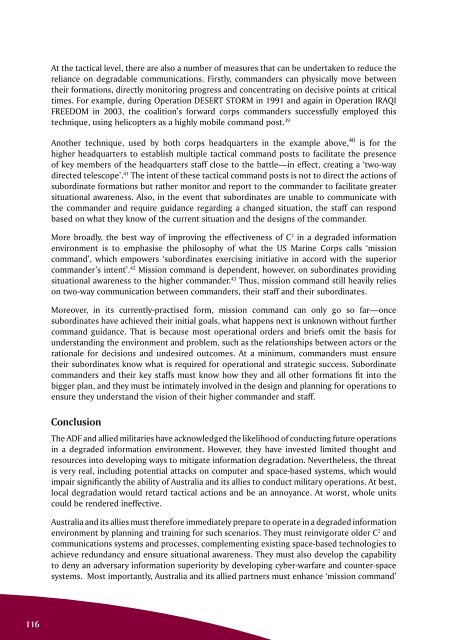190%202013%20Mar_Apr
190%202013%20Mar_Apr
190%202013%20Mar_Apr
Create successful ePaper yourself
Turn your PDF publications into a flip-book with our unique Google optimized e-Paper software.
116<br />
At the tactical level, there are also a number of measures that can be undertaken to reduce the<br />
reliance on degradable communications. Firstly, commanders can physically move between<br />
their formations, directly monitoring progress and concentrating on decisive points at critical<br />
times. For example, during Operation DESERT STORM in 1991 and again in Operation IRAQI<br />
FREEDOM in 2003, the coalition’s forward corps commanders successfully employed this<br />
technique, using helicopters as a highly mobile command post. 39<br />
Another technique, used by both corps headquarters in the example above, 40 is for the<br />
higher headquarters to establish multiple tactical command posts to facilitate the presence<br />
of key members of the headquarters staff close to the battle—in effect, creating a ‘two-way<br />
directed telescope’. 41 The intent of these tactical command posts is not to direct the actions of<br />
subordinate formations but rather monitor and report to the commander to facilitate greater<br />
situational awareness. Also, in the event that subordinates are unable to communicate with<br />
the commander and require guidance regarding a changed situation, the staff can respond<br />
based on what they know of the current situation and the designs of the commander.<br />
More broadly, the best way of improving the effectiveness of C 2 in a degraded information<br />
environment is to emphasise the philosophy of what the US Marine Corps calls ‘mission<br />
command’, which empowers ‘subordinates exercising initiative in accord with the superior<br />
commander’s intent’. 42 Mission command is dependent, however, on subordinates providing<br />
situational awareness to the higher commander. 43 Thus, mission command still heavily relies<br />
on two-way communication between commanders, their staff and their subordinates.<br />
Moreover, in its currently-practised form, mission command can only go so far—once<br />
subordinates have achieved their initial goals, what happens next is unknown without further<br />
command guidance. That is because most operational orders and briefs omit the basis for<br />
understanding the environment and problem, such as the relationships between actors or the<br />
rationale for decisions and undesired outcomes. At a minimum, commanders must ensure<br />
their subordinates know what is required for operational and strategic success. Subordinate<br />
commanders and their key staffs must know how they and all other formations fit into the<br />
bigger plan, and they must be intimately involved in the design and planning for operations to<br />
ensure they understand the vision of their higher commander and staff.<br />
Conclusion<br />
The ADF and allied militaries have acknowledged the likelihood of conducting future operations<br />
in a degraded information environment. However, they have invested limited thought and<br />
resources into developing ways to mitigate information degradation. Nevertheless, the threat<br />
is very real, including potential attacks on computer and space-based systems, which would<br />
impair significantly the ability of Australia and its allies to conduct military operations. At best,<br />
local degradation would retard tactical actions and be an annoyance. At worst, whole units<br />
could be rendered ineffective.<br />
Australia and its allies must therefore immediately prepare to operate in a degraded information<br />
environment by planning and training for such scenarios. They must reinvigorate older C 2 and<br />
communications systems and processes, complementing existing space-based technologies to<br />
achieve redundancy and ensure situational awareness. They must also develop the capability<br />
to deny an adversary information superiority by developing cyber-warfare and counter-space<br />
systems. Most importantly, Australia and its allied partners must enhance ‘mission command’


